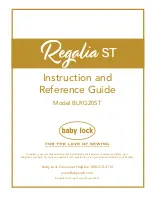
There are thread loops on the underside of the material:
A tangle on the bottom side of the material means there is not enough upper tension.
More than likely, the thread is not being pulled snugly between the tension disks (p.
47,
66
E
&
F
) on the upper tension assembly or is not between them at all.
1.
Lift the presser foot (to push the two tension disks apart) (p. 34,
54
)
2.
Firmly pull the thread against the center shaft between the disks.
3.
Drop the presser foot. The disks should close on the thread creating plenty of tension. Gently
pull on the thread to feel the tension.
4.
If this did not solve the problem, pull the cover knob off the upper tension assembly and turn
the knob found underneath to the point where its outer surface has three threads of the end
of the tension post showing. Then repeat steps 1–3.
Thread loops could also be caused by a burr on the retaining ring cap spring (p. 50,
68
B
).
Remove any burrs by polishing them with emery paper or a fine file. If badly damaged, replace
with a new retaining ring cap spring (#1603).
Thread pulls out of the needle eye when starting to sew:
Confirm that the needle eye is threaded from left to right (p. 29,
47
I
). Then pull out a longer
thread tail and trap it with your finger to the bed of the sewing machine. Release the thread tail
after the first few stitches.
A rat’s nest forms in the first few inches of sewing and then clears up:
Eliminate this formation by trapping the thread tails from the needle and the bobbin to the bed of
the sewing machine as you start to sew.
When stopping to turn a corner, the machine skips a stitch even with the
needle buried:
Bury the needle to the bottom of its travel and allow it to rise 1/8 inch. In this spot, raise the
presser foot and then pivot the work on the needle to change sewing direction. Drop the foot
to continue sewing. Follow this process to achieve the best quality corner stitch and minimize
skipping of stitches at turns.
When removing fabric from under the machine it pulls hard and three
strands of thread come up through the throat plate:
Typically this happens when material is being removed during the middle of a stitch. The hook
under the machine still has a loop of thread around it.
Before removing material from under the machine, manually turn the machine forward until the
take-up arm has just passed the top of its travel. This allows the hook to release the thread loop
and proper upper tension to be applied to finish the stitch (see p. 39).
Stitch Master
®
Guidebook: Troubleshooting
54
53
















































